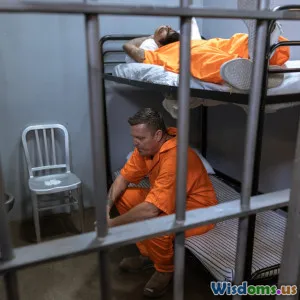
Are Restorative Justice Programs Better for Juvenile Offenders
9 min read Exploring how restorative justice transforms juvenile rehabilitation, fostering accountability, healing, and reduced recidivism through innovative community approaches. (0 Reviews)
Are Restorative Justice Programs Better for Juvenile Offenders?
Introduction
In the realm of juvenile justice, the question of how best to rehabilitate young offenders sparks intense debate. Traditional punitive systems often focus on punishment and incarceration, but these approaches frequently fail to address the underlying causes of delinquency or promote lasting positive change. Enter restorative justice programs—a growing alternative that emphasizes accountability, community engagement, and healing. But are these programs truly better for juvenile offenders? This article delves into the transformative potential of restorative justice, backed by evidence, expert views, and global examples, revealing why it might be the better path for young lives at a crossroads.
Understanding Restorative Justice: A Paradigm Shift
What is Restorative Justice?
Restorative justice (RJ) is an approach that seeks to repair the harm caused by criminal behavior through inclusive processes that engage victims, offenders, and the community. Rather than focusing on punishment alone, RJ prioritizes dialogue, responsibility-taking, and making amends. For juveniles, this method encourages personal growth and offers a chance to rebuild trust in their communities.
Key elements of RJ include:
- Victim-offender mediation: Facilitated meetings allowing victims to express their feelings and offenders to accept responsibility.
- Community involvement: Repair strategies include community service or other reparative measures.
- Focus on future behavior: Development of agreements that promote positive behaviors and reduce reoffending.
Why Traditional Juvenile Justice Models Fall Short
Juvenile justice systems have long emphasized deterrence through penalties, often resulting in detention or probation. However, studies have shown this approach may inadvertently increase recidivism rates by exposing youth to negative influences and fostering resentment. For example, the Office of Juvenile Justice and Delinquency Prevention (OJJDP) reports that approximately two-thirds of juvenile offenders released from detention facilities re-offend within three years.
In contrast, RJ aims to break this cycle by addressing emotional and social factors contributing to delinquency.
Benefits of Restorative Justice Programs for Juveniles
1. Reducing Recidivism
Multiple studies demonstrate that RJ programs significantly decrease repeat offending among juveniles. A meta-analysis published in the Journal of Experimental Criminology (2016) found that participation in restorative practices reduced recidivism rates by an average of 14% compared to traditional justice processes.
Example: The Christchurch Youth Restorative Justice Programme in New Zealand reported a 30% reduction in reconvictions over five years by integrating RJ into their juvenile system.
2. Empowering Victims and Healing Communities
Restorative justice offers victims a voice and a role in the process, unlike court proceedings where they can feel marginalized. This inclusion fosters healing and satisfaction, which is especially crucial for juvenile cases where conflicts may involve peers or local community members.
3. Promoting Accountability and Empathy
For juveniles, understanding the impact of their actions on others nurtures empathy and moral development. RJ’s focus on dialogue and face-to-face meetings encourages sincere accountability—transforming offenders from repeat offenders to responsible citizens.
In contrast, punitive systems often isolate youth, discouraging reflection and personal growth.
4. Cost-effectiveness and Reduced System Burden
Community-based RJ programs can alleviate overcrowded juvenile detention facilities and reduce overall costs. According to a Washington State Institute for Public Policy report, RJ programs yield a positive return of $23 for every dollar invested, factoring in reduced recidivism and incarceration expenses.
Real-World Insights: Examples of Restorative Justice in Action
New Zealand: Pioneering Restorative Justice for Youth
New Zealand's youth justice system integrates RJ broadly. Youth offenders undergo family group conferences to decide reparative actions. This participatory model has decreased custodial sentences by 20%, and recidivism rates are among the lowest globally.
United States: Growing Adoption and Promising Results
Countries with traditionally punitive models are increasingly adopting RJ. For instance, the Denver Juvenile Diversion Program connects youth with facilitators who guide restorative dialogues. A 2018 evaluation revealed that fewer than 10% of participants reoffended within a year—a notable improvement.
Canada: Balancing Accountability and Rehabilitation
Canada’s approach, especially within Indigenous communities, incorporates RJ to respect cultural values while addressing youth offending. Programs like Healing Circles foster reconciliation and community cohesion, demonstrating respect for tradition combined with modern justice principles.
Challenges and Criticisms of Restorative Justice
While RJ shows great promise, it isn’t without challenges.
Ensuring Voluntary Participation and Avoiding Coercion
True RJ depends on willing engagement from victims and offenders. Critics warn that coercion can undermine authenticity and outcomes.
Effectiveness for Serious Offenses
Some argue RJ might be less appropriate for violent or severe crimes, emphasizing the need for a hybrid approach rather than a full replacement of traditional methods.
Training and Resource Requirements
Successful implementation demands skilled facilitators and sufficient funding, which may not be available across all jurisdictions.
The Future: Integrating Restorative Practices in Juvenile Justice
To maximize benefits, policymakers and practitioners advocate blending restorative justice with conventional systems. Early intervention programs, school-based RJ initiatives, and community partnerships create supportive environments preventing delinquency before it escalates.
Prominent social psychologist Dr. Howard Zehr, often called the “father of restorative justice,” frames it as "a journey toward healing, not merely a method of punishment."
Conclusion
Restorative justice programs present a compelling alternative for working with juvenile offenders by prioritizing healing, responsibility, and community engagement over punitive measures. Empirical evidence confirms their effectiveness in reducing recidivism, empowering victims, and offering youths a pathway toward positive development. While challenges remain, the growing global consensus suggests RJ isn’t just better—it’s essential for creating fairer and more effective juvenile justice systems. As society aims to nurture rather than just penalize youth, embracing restorative approaches offers hope to troubled young lives and the communities striving to support them.
Take Action
Supporting restorative justice means advocating for policies that fund and expand such programs, educating communities about their benefits, and encouraging juvenile justice reform that centers on healing and growth. For individuals, engaging with local restorative initiatives or volunteering in youth programs can make a tangible difference.
Transforming juvenile justice starts with a single conversation—could restorative justice be the one that changes everything?
References
- Office of Juvenile Justice and Delinquency Prevention (OJJDP)
- Journal of Experimental Criminology, 2016 Meta-Analysis
- Washington State Institute for Public Policy, Cost-Benefit Analysis
- Howard Zehr, "The Little Book of Restorative Justice"
- New Zealand Ministry of Justice Publications
- Denver Juvenile Diversion Program Evaluations
- Indigenous Healing Circles, Canadian Studies
Rate the Post
User Reviews
Popular Posts

















